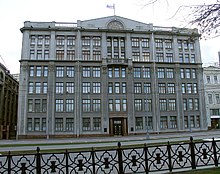Politburo of the CPSU Central Committee
|
Politburo Политбюро Politbyuro |
|
|---|---|
 |
|
| Leadership | |
|
Status
|
In practice, the highest organ in Soviet politics
|
|
Leader
|
|
|
Elected by
|
|
|
Responsible to
|
The Central Committee
|
| Seats | Varied |
| Meeting place | |
 |
|
| Staraya Square, Moscow, Russian SFSR | |
The Politburo (Russian: Политбюро; IPA: [pəlʲɪtbʲʊˈro], full: Political Bureau of the Central Committee of the Communist Party of the Soviet Union, abbreviated Политбюро ЦК КПСС, Politbyuro TsK KPSS) was the highest policy-making government authority under the Communist Party of the Soviet Union. It was founded in October 1917, and refounded in March 1919, at the 8th Congress of the Bolshevik Party. It was known as the Presidium from 1952 to 1966. The existence of the Politburo ended in 1991 with the breakup of the Soviet Union.
On August 18, 1917, the top Bolshevik leader, Vladimir Lenin, set up a political bureau – known first as Narrow composition and, after October 23, 1917, as Political bureau – specifically to direct the October Revolution, with only seven members (Lenin, Trotsky, Zinoviev, Kamenev, Stalin, Sokolnikov, and Bubnov), but this precursor did not outlast the event; the Central Committee continued with the political functions. However, due to practical reasons, usually fewer than half of the members attended the regular Central Committee meetings during this time, even though they decided all key questions.
The 8th Party Congress in 1919 formalized this reality and re-established what would later on become the true center of political power in the Soviet Union. It ordered the Central Committee to appoint a five-member Politburo to decide on questions too urgent to await full Central Committee deliberation. The original members of the Politburo were Lenin, Leon Trotsky, Joseph Stalin, Lev Kamenev and Nikolai Krestinsky.
...
Wikipedia
